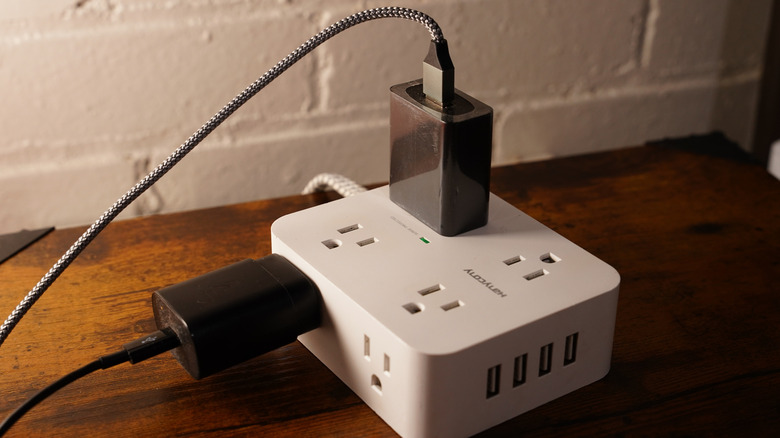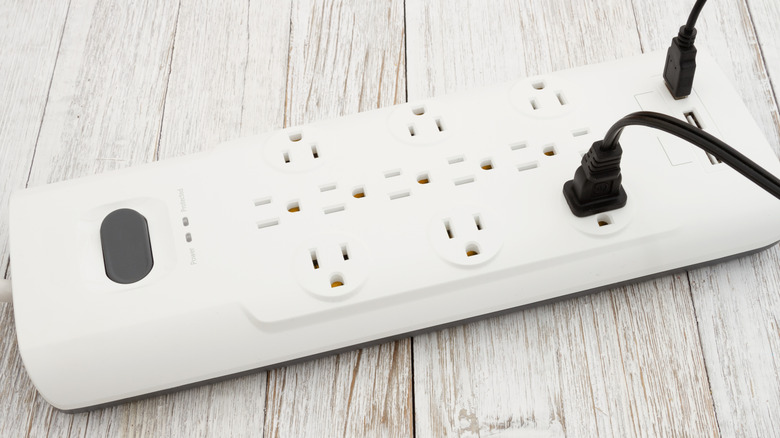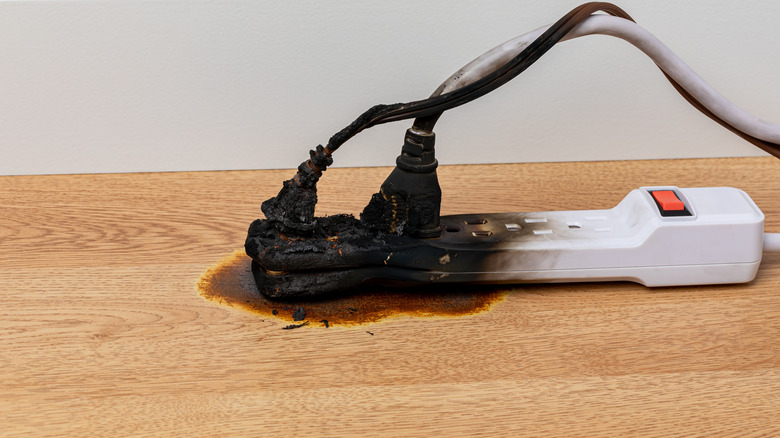Why You Shouldn't Plug A Surge Protector Into Another Surge Protector
Given the number of devices we use that must be plugged in from time to time to charge (like phones and tablets) or simply need to stay powered on whenever they're in use (like TVs and gaming consoles), many of us find our homes don't have enough power outlets to meet the demand, especially if we live in an older building. If you're like many people, you've probably used power strips and surge protectors as a workaround for this problem. These handy devices can turn one power outlet into several, making it easier to keep everything plugged in at once.
As useful as surge protectors are, you might find that one just isn't enough for all the electronics you need to plug in. The solution may seem obvious: plug one surge protector into another to make even more power outlets available for your use. However, that's not something you should do. Plugging one surge protector or power strip into another is called daisy-chaining, and it comes with some serious risks, including overheating, fire hazards, and voided warranties on your devices and the surge protectors themselves.
What happens when you plug one surge protector into another?
Just like surge protectors are one of the devices you should never plug into an extension cord, connecting one surge protector to another is something you should never do. While it may seem like a good idea when power outlets are at a premium, this seemingly innocent practice can have serious consequences. That's because each surge protector is rated for a specific electrical load, which tells you how much power it can safely handle before it fails. When you plug one surge protector into another, they can exceed this capacity, especially the one closest to the wall outlet, which ends up bearing the brunt of the load. This can cause overheating, tripped breakers, and even fires.
Most surge protectors are UL-listed for stand-alone use, meaning you can't string them together because they're not designed to handle the combined draw of multiple devices downstream. If you take a look at the instructions that came with your surge protector (keep in mind that some don't come with any), you may notice that it includes guidance to plug it directly into a wall outlet. If you don't use the surge protector as outlined in the manufacturer's guidelines, you might void both the surge protector's warranty and the warranty on any devices plugged into it.
Daisy-chaining is so problematic that it's considered a violation of Occupational Safety and Health Administration (OSHA) workplace safety standards and goes against the National Electrical Code (NEC). While you don't have to follow OSHA and NEC regulations in your home, the safety risks still apply, making daisy-chaining surge protectors a bad idea wherever you are.
Does using multiple surge protectors provide extra protection?
When it comes to many things, we often think that two is better than one. However, that's not the case with surge protectors. Doubling up on surge protectors by plugging one into another won't give your devices any extra protection because they're not designed to work in a chain. You may be aware of the risks that come with using a laptop during a storm if lightning strikes, causing a power surge while it's plugged in and charging. It's for this reason that many of us turn to surge protectors, expecting them to protect our valuable equipment.
However, daisy-chaining a surge protector can make it less effective or even useless during a power surge because the extra load can prevent it from working properly, leaving your devices unprotected. A surge protector's internal components are designed to absorb spikes in voltage, and connecting them in a chain can interfere with that process. Instead of bringing added protection to your plugged-in devices, daisy-chaining can actually reduce it and may even increase the chance your equipment is damaged during a power surge.


